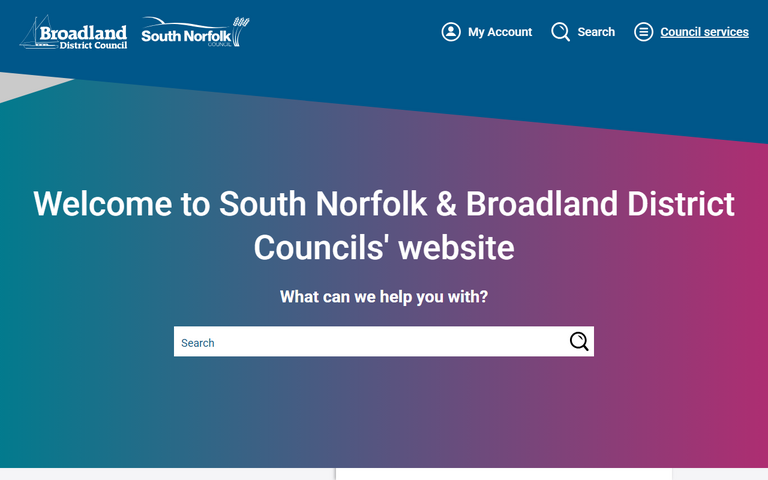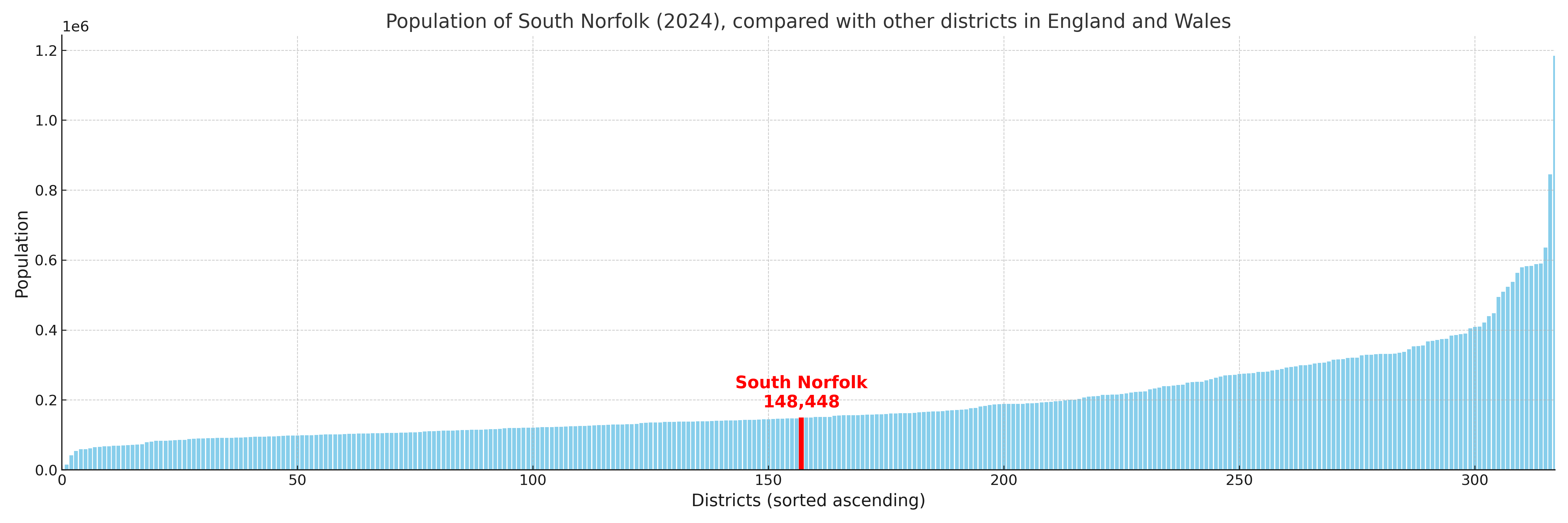South Norfolk
§ This page gives an overview of the South Norfolk local authority district, bringing together key facts, maps, and data to help you quickly understand the area. One of 361 district profiles on Baseview.
Overview ⁞ South Norfolk is a largely rural district surrounding Norwich, characterised by farmland, woodlands, and traditional villages. Market towns like Diss, Wymondham, and Harleston are key centres, with historic churches, abbeys, and bustling markets. The River Waveney forms part of its southern boundary, offering scenic landscapes and wildlife. The countryside is dotted with flint cottages, windmills, and walking routes, while the area’s proximity to Norwich adds to its appeal.
South Norfolk Boundary Map
This map shows the official boundary of the South Norfolk local authority district, based on the latest geographic data published by the Office for National Statistics (ONS). It provides a clear view of the district’s extent and helps you understand how the area fits within the wider regional and national landscape.
Contains OS data © Crown copyright and database right 2025. Source: Office for National Statistics licensed under the Open Government Licence v3.0.
The administrative boundary of South Norfolk can also be viewed on OpenStreetMap: District Boundary of South Norfolk.
Key Facts about South Norfolk
What region is South Norfolk in? South Norfolk is in the East of England of England, a region within the UK.
What county is South Norfolk in? South Norfolk is located in the county of Norfolk.
Is South Norfolk a city? No, South Norfolk is not a city. (Note: the UK has 76 officially designated cities.)
Who governs South Norfolk? The local authority for this district is: South Norfolk District Council - responsible for district-level services. Since Norfolk is a two-tier area, county-level services are handled by: Norfolk County Council.
▶ Official website of South Norfolk District Council 🔗 southnorfolkandbroadland.gov.uk

Which police force covers South Norfolk? Policing in South Norfolk is provided by Norfolk Constabulary 🔗 norfolk.police.uk, which serves 7 local authority districts: Breckland ⁞ Broadland ⁞ Great Yarmouth ⁞ King's Lynn and West Norfolk ⁞ North Norfolk ⁞ Norwich ⁞ South Norfolk.
South Norfolk in International Geographies
In the International Territorial Levels (ITLs) hierarchy, South Norfolk is within an ITLs Level 3 area:
- (ITL 1) East of England
- (ITL 2) ⇒ Norfolk
- (ITL 3) ⇒⇒ Breckland and South Norfolk
The International Territorial Levels are used by OECD member countries for statistical purposes to classify administrative areas. We have this listable page for easy browsing of ITL names and codes: International Territorial Levels.
Constituencies in South Norfolk
South Norfolk is divided into 4 parliamentary constituencies, listed below in alphabetical order.
A constituency is a specific geographical area that elects one Member of Parliament (MP) to represent them in the House of Commons. The United Kingdom is divided into 650 parliamentary constituencies. We have this list page for easy browsing of all UK parliamentary constituencies: List of Constituencies.
Wards in South Norfolk
South Norfolk is divided into 26 wards, listed below in alphabetical order.
- Beck Vale, Dickleburgh & Scole
- Bressingham & Burston
- Brooke
- Bunwell
- Central Wymondham
- Cringleford
- Diss & Roydon
- Ditchingham & Earsham
- Easton
- Forncett
- Harleston
- Hempnall
- Hethersett
- Hingham & Deopham
- Loddon & Chedgrave
- Mulbarton & Stoke Holy Cross
- New Costessey
- Newton Flotman
- North Wymondham
- Old Costessey
- Poringland, Framinghams & Trowse
- Rockland
- South Wymondham
- Stratton
- Thurlton
- Wicklewood
In the UK, a ward is a subdivision of a local authority area, used mainly for electoral and statistical purposes. Defined by the ONS, wards represent the primary unit for local elections, each returning one or more councillors to the local council. Wards are also used as a key geography for presenting population and census data.
Parishes in South Norfolk
South Norfolk is part-parished: 118 civil parishes (listed A-Z below) alongside 1 unparished areas.
- Alburgh
- Aldeby
- Alpington
- Ashby St. Mary
- Ashwellthorpe and Fundenhall
- Aslacton
- Barford
- Barnham Broom
- Bawburgh
- Bedingham
- Bergh Apton
- Bracon Ash
- Bramerton
- Brandon Parva, Coston, Runhall and Welborne
- Bressingham
- Brockdish
- Brooke
- Broome
- Bunwell
- Burgh St. Peter
- Burston and Shimpling
- Caistor St Edmund and Bixley
- Carleton Rode
- Carleton St. Peter
- Chedgrave
- Claxton
- Colney
- Costessey
- Cringleford
- Denton
- Deopham
- Dickleburgh and Rushall
- Diss
- Ditchingham
- Earsham
- East Carleton
- Easton
- Ellingham
- Flordon
- Forncett
- Framingham Earl
- Framingham Pigot
- Geldeston
- Gillingham
- Gissing
- Great Melton
- Great Moulton
- Haddiscoe
- Hales
- Heckingham
- Hedenham
- Hellington
- Hempnall
- Hethersett
- Heywood
- Hingham
- Holverston
- Howe
- Keswick and Intwood
- Ketteringham
- Kimberley and Carleton Forehoe
- Kirby Bedon
- Kirby Cane
- Kirstead
- Langley with Hardley
- Little Melton
- Loddon
- Long Stratton
- Marlingford and Colton
- Morley
- Morningthorpe and Fritton
- Mulbarton
- Mundham
- Needham
- Newton Flotman
- Norton Subcourse
- Poringland
- Pulham Market
- Pulham St. Mary
- Raveningham
- Redenhall with Harleston
- Rockland St. Mary
- Roydon
- Saxlingham Nethergate
- Scole
- Seething
- Shelfanger
- Shelton and Hardwick
- Shotesham
- Sisland
- Spooner Row
- Starston
- Stockton
- Stoke Holy Cross
- Surlingham
- Swainsthorpe
- Swardeston
- Tacolneston
- Tasburgh
- Tharston and Hapton
- Thurlton
- Thurton
- Thwaite
- Tibenham
- Tivetshall
- Toft Monks
- Topcroft
- Trowse with Newton
- Wacton
- Wheatacre
- Wicklewood
- Winfarthing
- Woodton
- Wortwell
- Wramplingham
- Wreningham
- Wymondham
- Yelverton
A civil parish is the lowest tier of local government in England, used for villages, small towns, and suburbs. They have their own local authority, either a parish council or a parish meeting, which provides local services like managing parks, allotments, and streetlights, and represents the community's views to larger councils.
Built-up Areas in South Norfolk
South Norfolk covers 76 built-up areas, listed below in alphabetical order.
- Alburgh Street
- Alpington and Yelverton
- Ashwellthorpe
- Barford (South Norfolk)
- Beccles *
- Bracon Ash
- Bressingham
- Brooke
- Bungay *
- Bunwell
- Burgh St Peter
- Burston
- Chedgrave
- Colney *
- Colton (South Norfolk) *
- Costessey *
- Cringleford *
- Dickleburgh
- Diss *
- Ditchingham
- Earsham *
- Easton (Broadland) *
- Ellingham and Kirby Cane
- Geldeston
- Gillingham (South Norfolk)
- Great Moulton
- Haddiscoe
- Hales
- Harleston
- Hempnall
- Hempnall Green
- Hethersett
- Hingham
- Little Melton
- Loddon
- Long Stratton
- Mattishall *
- Morley St Botolph
- Morley St Peter *
- Mulbarton
- Needham
- Newton Flotman
- Norwich *
- Poringland
- Pulham Market
- Pulham St Mary
- Queen's Hills *
- Reedham *
- Rockland St Mary
- Roydon (South Norfolk)
- Saxlingham Nethergate
- Scole
- Seething
- Shelfanger
- Shotesham
- Sneath Common
- Snow Street
- St Olaves *
- Stoke Holy Cross
- Surlingham
- Swainsthorpe
- Swardeston
- Tacolneston
- Tasburgh
- Taverham and Drayton *
- Thurlton
- Thurton
- Tibenham
- Tivetshall St Mary and Tivetshall St Margaret
- Trowse Newton
- Wacton
- Wicklewood
- Woodton
- Wortwell
- Wreningham
- Wymondham (South Norfolk)
In the UK, a Built-up Area (BUA) is a continuous urban area of at least 20 hectares (0.2 km²), defined by the ONS as land where buildings are generally no more than 200 metres apart, such as towns, cities, or large villages. (Note: A BUA name marked with an asterisk (*) indicates that the area is situated partly in the district of South Norfolk.)
South Norfolk compared with other districts in the UK
This section shows how South Norfolk compares with other local authority districts in the UK, using a variety of measures and rankings.
South Norfolk has 26 electoral wards.

South Norfolk has a population of 148,448 (2024 mid-year estimate by ONS)

More local statistics and data for South Norfolk can be found on the ONS statistics for South Norfolk.